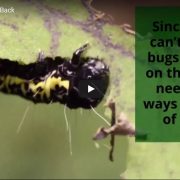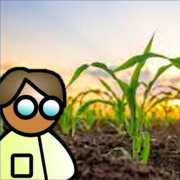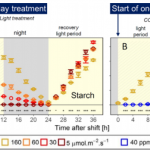Plants are thirsty, too!
ASPB Conviron Scholars: Final Project, by Tim Burnette
Water is a central piece to humanity’s past, present, and future life. It is essential to our survival, and we are not alone in this necessity: plants need water too. With limited water, plants cannot grow and develop, and may not even survive. But recent research has demonstrated that drought, a shortage of water over a period of time, will be more frequent and more extreme in the future.
While humans can migrate to places with water, plants are immobile. They must sense, respond, and adapt to dry conditions or face certain death. Understanding how plants act at each of these steps is important for agriculture but also the wild.
Why sense drought? To deal with drought, plants must first sense drought and understand that it is occurring. With drought becoming more common, sensing is crucial. Especially concerning is the potential of a megadrought, a prolonged drought lasting two decades or longer, which is believed to be hitting the American southwest now.
Plants can communicate long distances within themselves much like humans. For example, humans with low blood pressure produce more of the hormone vasopressin. This hormone circulates in your blood and causes blood vessels and arteries to constrict and increase blood pressure to normal levels. Within plants, hormones are crucial to signaling stressful environmental conditions like drought. One such hormone is abscisic acid (ABA). It signals to plants that dry conditions are ahead.
ABA also has a large role in signaling between plants. Trees can communicate that drought is occurring through ABA. ABA is secreted by a droughted tree out of its roots, and other trees take up the compound through their roots. Once the signal is received, plants must respond.
Plants can respond to drought in a few ways. Once signaled of drought, plants must respond to it. This occurs within an individual plant, in its lifetime only. One of the first ways plants usually respond is by closing their stomata, which is initiated by ABA. Stomata are the small holes or pores on leaves through which water is lost and carbon dioxide is absorbed. But if drought hits, stomata close so that plants don’t lose their water!
Plants also need to control the amount of water inside of themselves. Osmosis, the movement of water across a membrane (like a cell membrane) to an area where these is less water. Typically, this happens to dilute other molecules (like salts and sugars). But when drought stressed, plants have less water for diluting. This is where osmotic adjustment, or a change in other molecules’ concentration in a cell, acts to reduce water loss out of the cell. Many different compounds help with osmotic adjustment, ranging from sugars to small proteins, but they are crucial to helping plants tolerate drought.
How can plants adapt to drought? Plants can also prepare for drought by changing across longer time scales. This works based on the concepts of inheritance and evolution. Inheritance is the idea that parents pass on their traits to offspring. Similar to how humans pass on eye color, plants can pass on characteristics that are beneficial to surviving drought. Evolution, or gradual change across long timescales, suggests that plants can change their characteristics to better survive drought.
Several characteristics or traits are important for adapting to drought. Before plants are even growing, seeds may face drought. If drought is too extreme, seeds may not germinate or develop at all. This means the seed stays in the soil until there is more water. Once growing, plants can also root deeper to reach different water or root more horizontally to collect all of the surface water in soils. This is important for plants to delay the effects of drought, as these water sources will also fail if there is an extreme drought.
Plants have also evolved to lose less water and/or store more water. Plants can have less stomata, which limits the bulk amount of water they lose out of their pores. In this way they delay the effects of drought. It is possible as well to store more water. All plants store some water, but cacti that are called succulents are well-known for storing extravagant amounts of water. This is the result of immense evolution but helps plants to avoid drought as they use this stored water when the environment is dry.
Plants can also change their developmental timing. From year to year we find that some plants are flowering earlier and earlier. This is because plants don’t want to experience drought, so they finish their lives before then. So, if drought hits mid-June, plants will grow and flower before then and they escape drought.
So, why should we care?
Plant mortality from drought is increasingly a problem. One of the largest cases of plant mortality is pinyon (Pinus species), and to a lesser extent juniper (), in the pinyon-juniper woodlands. Pinyon deaths from drought are more common than ever before. These deaths have largely occurred between 2003-2005 and continue until now. In particular, smaller pinyon trees are dying, and trees that exist on lower mountain slopes (lower in elevation) also face higher mortality.
Death of trees presents several problems for wildlife and humanity. If trees die, that is less habitat for animals and less food for insects—it can disrupt the ecological harmony of an area. Further, these dead trees are kindling for our next fire crisis. While fires are natural, they also become extreme in these regions with tree dieback and can harm other plants, animals, and humans living nearby. Regions with large amounts of death are also less aesthetically-pleasing.
Crops face drought, too. Corn is a crucial crop worldwide and responds highly negatively to drought—even four days of drought can lead to yield losses or less food produced. Corn facing drought grows less, has poorly filled cobs, and has rolled leaves. Drought at any point in the corn life cycle has negative effects on crop yields, but drought that hits when the cobs are filling is particularly bad for yields. With increasing drought worldwide, corn yields may drop, decreasing corn stock in grocery stores but also increasing gas prices through increased ethanol prices.
In all: plants can be thirsty too! And their thirst is only going to increase with more frequent drought across the globe, but especially in the American southwest, and this may have increasingly harmful effects on the environment. Not only should we fear more wide-spread wildfires, but humanity may start to feel the impact of drought in our food systems. The possible ways through which plants can respond and adapt to drought are crucial for the future of plants in both wild and natural systems.









Leave a Reply
Want to join the discussion?Feel free to contribute!